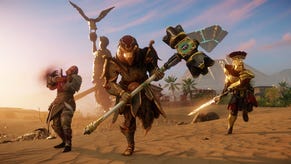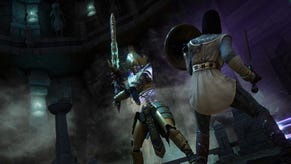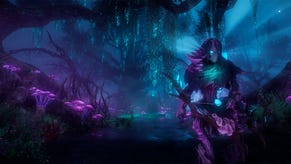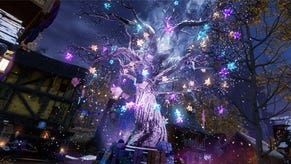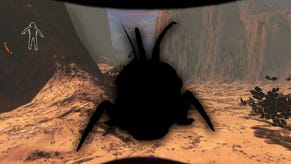How New World transformed from a toxic survival horror game into a juggernaut MMO
We talk to Amazon Games' senior producer about New World's development
New World, Amazon Games' opening move into game dev, was not always an MMORPG. It used to be a survival horror game. According to Katy Kaszynski, senior producer at Amazon Games, the team got really far down that road. "They created it. That was before my time, but that game was almost done," Kaszynski tells me, just after delivering a presentation on New World's development at this year's Develop Conference in Brighton. "They really thought it was going to go alpha, launch, and they were going to ship that out."
A survival horror is pretty different from the jaunty, vaguely piratical, magical fantasy RPG that New World is today: lush forests, sunny grassy plains, and factions engaged in an endless war for territory. So what happened? According to Kaszynski, it's all down to Amazon's first 'Leadership Principle': Customer Obsession.
Whatever my view of Amazon as a whole - a company which, it seems to me, is less a company and more a mechanism to send one billionaire to the moon in a rocket powered by the closure of book shops - I have no beef with its individual employees, and it is undeniable that New World made an impact when it launched. Even Kaszynski describes Amazon, and Amazon Games, as peculiar.
"It's definitely an odd group of people doing really cool things," she says. Amazon's Leadership Principles are the sort of thing you'll recognise if you've ever worked at a big enough company - especially if there's an office somewhere in North America. They're often tortured backronyms like SWIFT or SERVE or BIG CHUG or whatever. You forget they exist until annual review season. You know what I mean. Customer Obsession, in real people talk, just means working backwards from what customers say they want.
The devs noticed that in the alpha of the survival horror version of New World, more experienced players were just... just absolutely ganking new players as they were brought into the alpha. The older players were, obviously, enjoying this. The newer players? Not so much. Kaszynski notes that if players are interacting with your game and end up making it a different game to the one you thought you'd created, that can be fine. It might be better than you imagined, or different in a good way. But the early version of New World had, she said, become "pretty toxic" in a way that made it apparent they needed to change.

"That's when we used player sentiment from the players that were having fun doing the toxic things, and the players that were like, 'Hey this is what I'd prefer,' and figured out how that still fit with our vision of this island that was somewhat mystical, and [players] being explorers and adventurers," Kaszynski explains. That's when the team made the big shift away from survival horror, and Kaszynski joined the team just after this.
Coming from a dotcom consumer background, Kaszynski worked as a programme manager on technical readiness for peak seasonal times. While she describes the move to working on a game as having a vertical learning curve, she says that in general release-managing a game is similar to release-managing other kinds of software. Working on the website meant she also had experience scaling to meet need, as well as understanding customer feedback. Devs at Amazon Games are encouraged to spend time in the game with the players, to see what they're doing, as well as listening to the requests of the community.
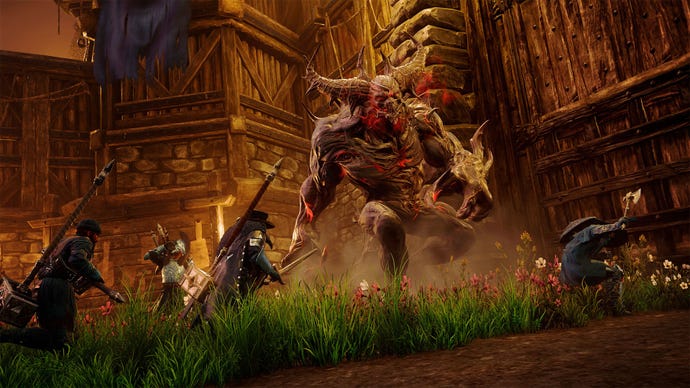
This involves figuring out what players are actually asking for, and how these needs work in relation to Amazon Games' own objectives for New World. It's a delicate tightrope to walk. "Mostly, it's we hear something that we're like, 'Duh. Why didn't we consider this? And it'll be not a lot of dev hours to complete, what are we doing?', and then we do quick turn arounds on those ones," Kaszynski says. Sometimes, though, even the players can't agree on what they want.
In her Develop talk, Kaszynski brought up mounts as an example, which don't exist in New World (and, if the lore is to be believed, cannot). The primary function of a mount is to get you around a game world quickly, so the devs put in fast travel shrines to service this need. But mounts are still something people are asking for, so they're still thinking about it. The other most polarising issue is a minimap. "There are people that are just die-hard, 'Give me a mount, give me a mini-map'," says Kaszynski, laughing, "and then there's other folks that are like, 'No, no! I like running around! How am I going to know there's that dye that I can harvest if I'm on a mount?'"
That's one of the reasons the devs are hesitant to whap in some big mounts: they're trying to get people excited about exploring, raiding a mob you come across or pausing to chop some wood because you're close to dinging your next logging skill point.

This sort of quiet, personal exploration is the bit Kaszynski enjoys most in New World. Her favourite thing is to spend time fishing in the game - something she doesn't like in real life. "The most relaxing thing for me to do is just pop a beer and then fish in my game," she says. She told her team this once and they sent her boxes of different beers, and fake fishing trophies. She enjoys seeing players doing this sort of thing, like the Town Criers, a group who formed after the alpha who would gather the (in-game) news of the day and then go to different settlements yelling this news out loud.
Even after developing alongside an open alpha, it wasn't at the player scale that New world has now, so the team are getting new and surprising data all the time. Everything, Kaszynski emphasises, is a conversation. "There's no just 'this is the right answer'. It has to be a conversation and you have to bring in as much data as you can, so that you can do what's in the best interest of your players and the game," she explains.
They're thinking about the future, but Kaszynki wouldn't be drawn into any specifics, because she doesn't want to make any promises before it's in her hand, ready to be shipped - something she regrets happening with the server transfers.
"That's now a broken promise to our players, and that's absolutely not who we want to be. That's not who I want us to be."
"In order to get it into the shape that it was in - which we thought was good, it turns out it wasn't that great - but in order to get it into the shape that we thought was good, we needed more time than we originally anticipated, and that's now a broken promise to our players," she says. "And that's absolutely not who we want to be. That's not who I want us to be."
A big expansion is coming, though, as you'd expect, but Kaszynski doesn't know when that will be. She says that the team have stuff they're considering "for the far future", some things that will go "into an expansion down the line", but there's a lot planned for the next year and a half. "That work [on the expansion] hasn't even started because we're so focused on developing this game that we have today, for our day one players and for everyone who's joined since."



